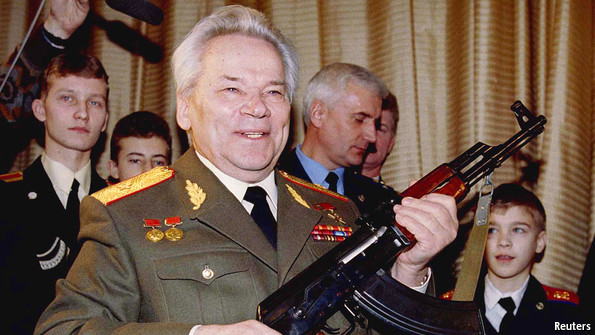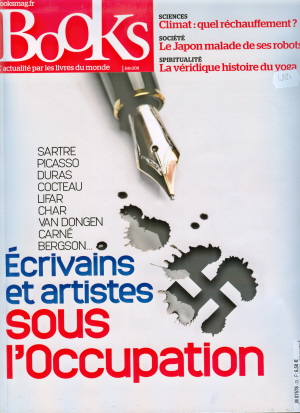
THE weapon is so simple that even a child can use it. Alas, many do. Pick it up, with its distinctive short barrel and curved magazine, and it feels compact, robust and not too heavy. The controls are easy. One lever swivels through three settings from safety to single shot to automatic fire. Changing the large magazine takes a few seconds. Although it is not that accurate, with a kick on the recoil, a competent user can fire around 100 bullets a minute. Best of all, it works fine in any conditions—wet, sand, jungle. Even when dirty, it almost never jams. It is cheap and quick both to make and to copy—of the 100m Kalashnikovs in circulation in 2009, about half were counterfeit. No wonder that, for 50 years, this has been the weapon of choice for guerrillas everywhere, from Vietnam to the Congo and from Nicaragua to Iraq.
Mikhail Kalashnikov laboured all his life to make his gun the best. He cared, as keenly as any craftsman, for order and simplicity. If he saw a piece of litter, he had to pick it up. If a fly dared to enter his apartment, he had to shoo it out. He liked to be surrounded only by lovely objects and good books: Montesquieu, Seneca and the Russian poets, Nekrasov and Esenin, whose works he had long tried to imitate. Lovely things included, to his mind, the AK-47. Though judged by others a pretty crude piece of kit, it was his passion, and he never ceased to try to perfect it.
This compulsive tinkering was inborn. Any old piece of machinery he found as a child on the family farm had to be taken apart, to see how it worked. He kept a cache of bits in the hope of making a perpetual-motion machine. As a teenager he fell in love with an old pistol, also repeatedly taken apart. He shed tears when, because it was illegal to carry such a thing, he had to throw the pieces away in the forest. Constant reassembling, as well as straight borrowing, were essential qualities in a weapons-maker. The AK-47 combined components from the Browning rifle and the Garand carbine, as well as elements unchanged from the 17th century.
For Motherland and Stalin
In appearance, especially in his winter coats, he was as short, compact and robust as his most famous gun was, and with ever-increasing rows of medals on his chest. Called up for war service, he made such a diminutive tank commander that he was better off inventing and designing. His first gadgets were for tanks, including a device to make it easier to fire a pistol through the slits. The idea for a better rifle came to him as he lay in hospital in 1941-42, his left shoulder shattered by shrapnel at the battle of Bryansk, and heard other soldiers moaning about the uselessness of their rifles, and how few they had. He knew that first-hand; on his way to the hospital, Germans armed with MP-38s had massacred the other injured men in his convoy. The Motherland had to be better defended. And the job was up to him.
His first ventures in weaponry were over-complicated and unsuccessful. He and his collaborators kept striving. His rifle design eventually won in 1947 (hence “47”), and became standard issue two years later. It was made for use by peasants like himself, the sort who filled the Soviet Union’s conscript army: untrained men more used to stacking hay, and wearing thick gloves against the cold. He later developed the PK light machinegun, also for them.
Someone told him that Stalin had kept the prototype AK-47 on his desk for several days. He thrilled to think of it—oddly, for it was on Stalin’s orders that his family in 1930 had been labelled kulaks (rich peasants and enemies of the people), evicted from their farm and deported to Siberia. In the same year, his father died from privation and exhaustion. As a teenager, he kept trying to get back to the village that had been home; he ended up wandering to Kazakhstan and working as an engineer at Matai railway station. He blamed Stalin for none of this, however. He loved him.
That love was all the more fervent because he felt branded for life as an enemy of the state. He kept his history quiet. At 30, when (to his huge surprise) he was made a deputy to the Supreme Soviet in honour of his inventions, he expected to be turned away from the first session. He never was in all the 30 years he served, but love and fear fuelled his devotion to his guns. He worked round the clock, neglected his family, never took holidays—unless you counted hunting trips with another of his inventions, the self-loading Saiga carbine.
All of it was done for Russia—or, strictly speaking, for the Soviet Union in which he still believed, not the modern country of bandits and nouveaux riches that he could hardly recognise. Not one kopeck came to him from the AK-47, he said. He lived comfortably enough but, like any wise peasant, had no surplus. His assault rifle was not patented until 1999, by which time the world was awash with copies.
He hated to see the uses his gun was put to: not least, in the hands of the mujahideen, to drive Soviet soldiers out of Afghanistan. But it was not his fault if politicians decided to resort to violence. So, despite everything, he slept well. He hoped to be remembered for his poetry, not his weapons. And, after a hearty meal of his own fish stew, well dosed with his own brand-name vodka, he would raise a glass with his favourite toast: “May our children live in peace.”

